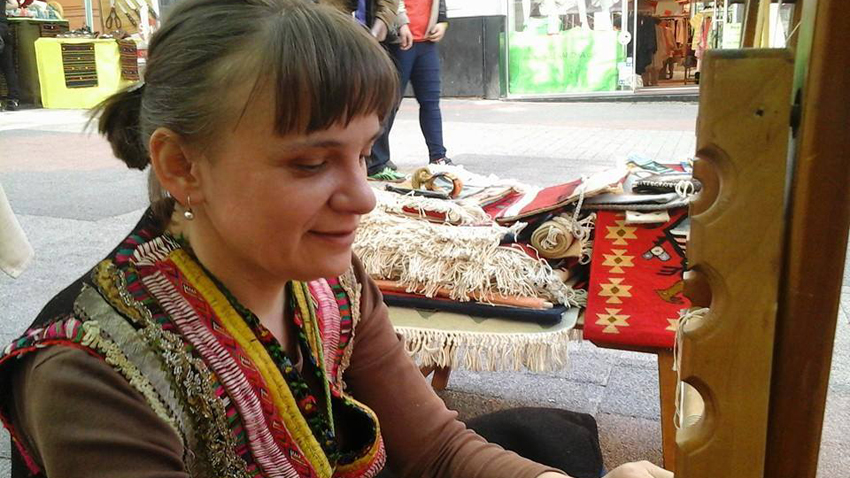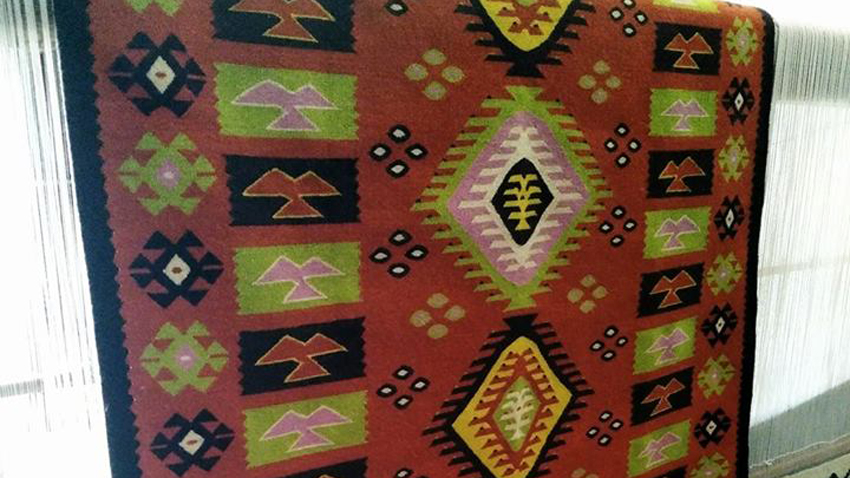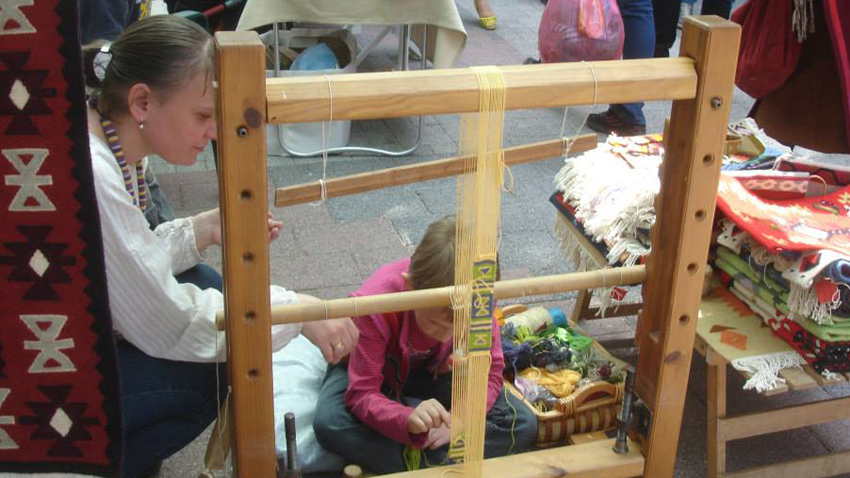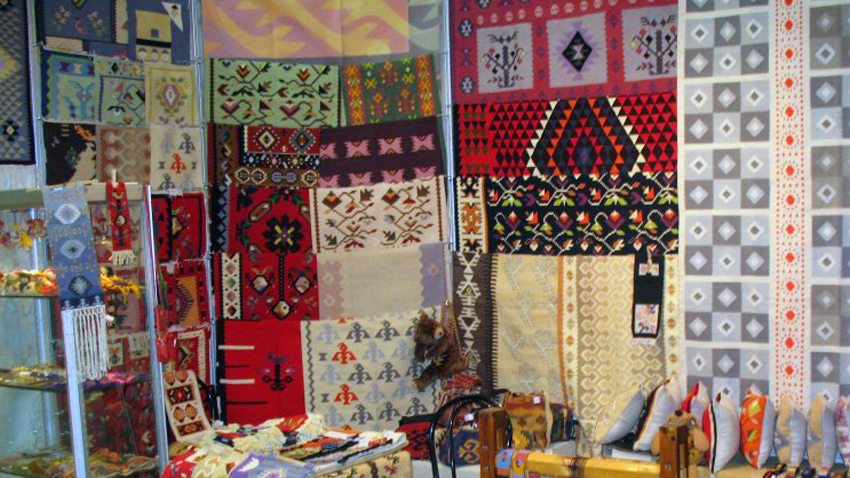Velika Stoeva from the Bulgarian town of Chiprovtsi has been weaving carpets since she was a child. All the women in her family were weavers and the weaving loom has always been present in her home. "It's been a profession for me for 20 years. It is very difficult to make a living with this craft because it takes time and effort, but it gives me strength and peace, "she says.” From the hands of the weavers, real works of art are born and they are highly valued by people with aesthetic feeling", the woman from Chiprovtsi adds. Some days ago, at Kapana Fest, in Plovdiv, she showed how some of the most beautiful carpets in Bulgaria are made in an outdoor studio devoted entirely to the Chiprovtsi kilim (carpet). The event was organized by the Plovdiv Together Foundation, which has been preparing the city for the European Capital of Culture in 2019. The aim is to provoke people's interest in handmade crafts and to show that they have a place in modern life. "Designing every carpet is the hardest part, and within one day the most skillful woman cannot finish a single pattern from the carpet she had planned. I guessed that in Plovdiv people will be interested in the carpets, but the interest surpassed my expectations,” she says.

 "I think it's not just the love of tradition. For modern people this is something distant, it does not happen every day and looks curious and interesting. During the workshop in Plovdiv we talked about carpets, the materials needed, we shared curious stories and it was a very useful and pleasant meeting for everyone. There were many children, and they were our bravest helpers who did not get tired for 5-6 hours helping us with the work. This makes me feel happy with our presentation at the festival. People who see a Chiprovtsi carpet appreciate the colors and patterns, its fabric and beauty, but when they try to make a similar thing, they understand the complexity and the price of the Chiprovtsi carpets. There are patterns that have been used for centuries and we are recreating them. We keep them as ornaments, composition and colors. They are entirely based on the authentic technique and the patterns, which distinguish the Chiprovtsi kilim from the others. I think that everything evolves, but it is important to keep the original look. No experiments must be made with the fabric of the carpet as no artificial fibers can replace wool. It is the best material for making them. Even if we added silk, we would be running away from the tradition. In modern life, smaller carpets, cushions and even handbags are made. This way we bring people closer to tradition.”
"I think it's not just the love of tradition. For modern people this is something distant, it does not happen every day and looks curious and interesting. During the workshop in Plovdiv we talked about carpets, the materials needed, we shared curious stories and it was a very useful and pleasant meeting for everyone. There were many children, and they were our bravest helpers who did not get tired for 5-6 hours helping us with the work. This makes me feel happy with our presentation at the festival. People who see a Chiprovtsi carpet appreciate the colors and patterns, its fabric and beauty, but when they try to make a similar thing, they understand the complexity and the price of the Chiprovtsi carpets. There are patterns that have been used for centuries and we are recreating them. We keep them as ornaments, composition and colors. They are entirely based on the authentic technique and the patterns, which distinguish the Chiprovtsi kilim from the others. I think that everything evolves, but it is important to keep the original look. No experiments must be made with the fabric of the carpet as no artificial fibers can replace wool. It is the best material for making them. Even if we added silk, we would be running away from the tradition. In modern life, smaller carpets, cushions and even handbags are made. This way we bring people closer to tradition.”

There are few masters of carpet weaving left in the town of Chiprovtsi, as most of them are now scattered across the country. Velika Stoeva is happy with her disciples and followers. "In many places of the world there are smooth carpets but the local carpets are distinguished by the ornaments. Chiprovtsi carpet weaving is different than all other carpet schools in the world," she says continuing:
"There are many different theories about the origin of the carpet and the beginning of this craft in Chiprovtsi. Documents proving how rugs were made in this town have existed since 1750. According to local legends, weaving carpets came into existence a long time ago. Some researchers claim that the craft came from the East as ancient Persia is its homeland. With the arrival of the Proto-Bulgarians in our lands, the tradition has been transferred. Here, in the process of interaction with the Thracian culture, the specific ornaments that exist only in Bulgaria emerged. In addition to them there are also symbols that are found all over the world. Interestingly, ornaments that are closest to the Chiprovtsi style are found in North America. One of the claims is that in the period of the great migration of peoples more than a thousand years ago, the Proto-Bulgarians and the Indians started their journey from one and the same place initially. This is the reason for such a similarity in the colors and ornaments of the Chiprovtsi carpet and the carpets of Native Americans. I like all the patterns of the Chiprovtsi carpet, but the most influential are the oldest preserved patterns, which are composed entirely of triangles in different compositions. The triangle is a symbol of the male and female beginnings, joined together, they recall of relationships in the family. Sometimes, among the symbols there is a sand clock that resembles the circle of life and nature. On the basis of the triangle, all other ornaments have later developed. A number of triangles depict a butterfly - a symbol of eternal life. Then the triangle develops into a circle that embodies the sun - a symbol of life as a whole. The birds that we also see in the carpets of Native Americans are also very characteristic of the Chiprovtsi carpet. They are a symbol of joy and life. But they are also believed to transport the souls of the dead to the other world. They are still seen on the carpets to teach us humbleness and remind us that we came to this world for a short time.”

English: Alexander Markov
Photos: courtesy of Velika StoevaJust a few weeks after being proclaimed Writer of 2024 at the annual Sofia City Library awards and after her Nishka (Thread) was declared novel of the year in the Bulgarian Literature category of the Ozone.bg awards, Victoria Beshliiska, author of..
At a special ceremony at the Romanian Embassy in Sofia, Ambassador Brândușa Ioana Predescu presented Bulgarian conductor Nayden Todorov with the Order of Cultural Merit with the rank of Grand Officer. "We are here to honor today your Maestro whom I..
Spanish writer Ana Andreu Baquero is coming to Bulgaria to present her novel "The Princess of Buchenwald" , the Cervantes Institute, which is organising the event with the Hermes publishing house, announced. The presentation of the book is scheduled..
Just a few weeks after being proclaimed Writer of 2024 at the annual Sofia City Library awards and after her Nishka (Thread) was declared novel of the..

+359 2 9336 661
